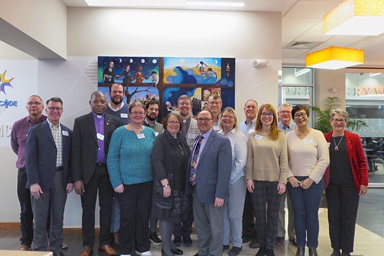Concerns about legislation and the future of The United Methodist Church got set aside for a half-hour at General Conference 2016 on Thursday, May 18, as delegates focused instead on a historical tragedy with deep Methodist involvement.
The 1864 Sand Creek Massacre was the subject, and speakers included a historian and descendants of the Cheyenne and Arapaho Indian survivors of the attack.
Mountain Sky Area Bishop Elaine J.W. Stanovsky had joined the descendants in planning the event, the latest effort yet by The United Methodist Church to atone for the Sand Creek Massacre.
“We’re here to listen and to tell the truth,” Stanovsky told delegates.
The visiting Native Americans — some of them dressed in traditional clothing — voiced appreciation.
“We now extend our hand in friendship to the Methodist Church,” said William Walks Along, a Northern Cheyenne descendent of massacre survivors. “We have developed a measure of trust, respect and honor for each other.”
Surprise attack
The Sand Creek Massacre occurred along the Big Sandy River of the Colorado Territory, beginning early on the morning of Nov. 29, 1864.
Col. John Milton Chivington, a Methodist Episcopal Church pastor who had joined the Union Army, led a surprise attack by 675 soldiers on a Cheyenne and Arapaho encampment.
The attack turned into slaughter, claiming about 200 Native American lives, including women, children and the elderly. Afterward, soldiers committed atrocities on the dead.
Some of Chivington’s more junior officers refused to participate, and the attack yielded condemnation and official investigations, as well as defense by newspapers and Colorado territory office-holders.
The United Methodist General Conference of 1996 apologized for the Methodist involvement in the massacre, but erred in some historical details and failed to show proper respect to descendants of the survivors, said Stanovsky.
In 2012, General Conference delegates engaged in an “Act of Repentance” worship service aimed at healing relationships with indigenous people, and approved a petition calling for full disclosure of the Methodist role in the Sand Creek Massacre.
Stanovsky and Otto Braided Hair Jr., a Northern Cheyenne descendant of survivors of the massacre, co-chaired the panel named to oversee a more complete remembrance.
A major step occurred in 2014, when Stanovsky led the Rocky Mountain Conference in a pilgrimage to the Sand Creek Massacre National Historic Site. That year, Stanovsky served on a state of Colorado Sand Creek Massacre Commemoration Commission.
Leading up to General Conference 2016, historian Gary L. Roberts – who has studied the Sand Creek Massacre for decades – prepared a 173-page report titled “Remembering The Sand Creek Massacre: A Historical Review of Methodist Involvement, Influence, and Response.”
The report, now out in book form by Abingdon Press, concludes that Chivington planned and carried out the massacre to further his career ambitions, and afterwards expressed no contrition, despite condemnation by fellow officers and others.
It also offers detail on the role of John Evans, a Methodist who served as territorial governor of the Colorado Territory. While he was not directly involved in the massacre, his policies created the conditions that made it possible, Roberts maintains. And Evans, one of the founders of Northwestern University, never accepted any responsibility.
Roberts’ third main conclusion is that the Methodist Episcopal Church (a predecessor to The United Methodist Church) “embraced the prevailing mind-set” of westward expansion by white settlers and defended Evans and Chivington after the massacre.
Roberts spoke to delegates on Thursday, calling his study of the Methodist involvement “sobering and challenging.”
He laid out details about Evans, Chivington and the attack, and concluded with an admonition to the delegates.
“Listen, learn and do not forget,” Roberts, a United Methodist, said.
Delegates gave the historian a standing ovation, and also rose in recognition of the survivors of the descendants.
The observance included the visitors’ singing of a Native American chief's song to remember and honor the chiefs present and those killed in the massacre. At the end, Stanovsky and other bishops presented gifts to the Cheyenne and Arapaho.
The Council of Bishops was to dine with them Thursday night.
Hodges, a United Methodist News Service writer, lives in Dallas. Contact him at (615) 742-5470 or [email protected].
Like what you're reading? Support the ministry of UM News! Your support ensures the latest denominational news, dynamic stories and informative articles will continue to connect our global community. Make a tax-deductible donation at ResourceUMC.org/GiveUMCom.




